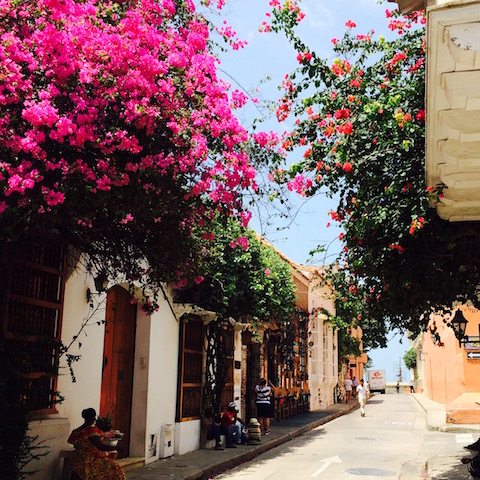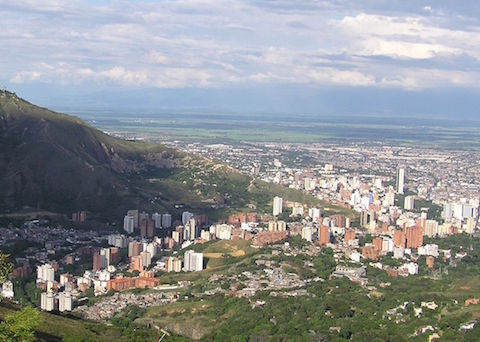How do you answer the question “Which is your favourite part of Colombia?” when you live in the most bio-diverse country on the planet? How can you possibly choose one favourite region, when they are all so completely different to each other? Maybe it’s just a case of when you know, you know. Fortunately, that is actually the case with me. I’ve had the good fortune to travel all around this incredibly diverse country and there’s one area I keep going back to more than any other. When I first visited Colombia and landed in Cartagena, I would have thought that it would be this magical, colonial city with its walled old town and easy-going, romantic and mesmerising mix of heat, colour, music and architecture. Our friends at El Pescador De Colores certainly fell in love with the place enough to set up what has proved to be the hottest opening of the year. On the island of Baru, they’ve launched a St Tropez/Ibiza/Miami inspired day club that provides a place to eat good food, drink decent rosé, soak up some sun and listen to a chilled mix of latin and European house. Fabulous!

A little bit further up the coast you come across Colombia’s oldest city, Santa Marta. It too has a colourful old town with a colonial heritage, but this city lies at the foothills of the Sierra Nevada, the highest coastal mountain range in the world. These snow-capped mountains almost fall into the Caribbean and so you can see the sun glistening off the snow while you lie in your hammock on the beach. That’s a pretty special sight. One of our favourite hidden gems of a hotel, Gitana Del Mar, is right on the beach outside Parque Tayrona and is a great base from which to explore the national park. Carrying on up the Caribbean coast, you get to the desert region, La Guajira. Most people don’t even realise there’s desert here, given that Colombia has the seventh highest rainfall of any country and over 75% of the country’s energy is produced from hydropower. La Guajira is sparsely populated with the country’s largest indigenous tribe, the Wayuu, who somehow survive in this barren land of salt plains, goats, sand and deserted beaches. If you like to get off the beaten track and go where few else care to venture, then this is the place for you. Check out both Magic Tour Colombia and Expotur for great tour guides to the region.
Switching oceans to the Pacific, on the country’s western coastline, you get a different type of beach experience altogether. This is an area that is almost inhospitable, with dense, thick jungle covering every square inch of land right up until the cliffs fall into the Pacific. But even the sides of the cliffs have trees impossibly clinging on so that to the eye it’s just a sea of green which merges into a sea of blue. There are hardly any roads along this coast, so a boat is the de rigueur mode of transport. As a result, the eco-system is completely unspoilt by humans and you only have to walk literally a couple of metres into the jungle before it envelops you completely. Every now and then there’s a break along the coast and a palm-fringed black sand beach provides the perfect setting for a gorgeous little eco-lodge. It’s from this handful of eco-lodges (we love both El Cantil and Punta Brava) that you can take boat trips to get up close and personal with the whales which arrive every year around July to play, mate and raise their young in the warm, sheltered waters. This is one of the best places in the world for whale-watching but the beauty is that it’s virtually unknown.
Moving inland away from the coastlines you can take your pick of different landscapes. The Andes split into three different ranges on reaching Colombia. These cordilleras form high plains where for example Bogota is built, but they also create deep valleys in which other cities are nestled such as Medellin. As you move towards the east of the country, the valleys become wider before giving way to flat plains that stretch off to the border with Venezuela. One of these valleys, the Cañon de Chicamocha in the Santander region, captures perfectly everything that is so wonderful about Colombia – beautiful mountain scenery, hundreds of varieties of flowers, an abundance of birdlife and a wealth of healthy, outdoor activities. The town of San Gil within the valley is the adventure capital of the country. There is world-class paragliding, mountain biking, white-water rafting and trekking to be had here, all surrounded by breathtaking natural beauty. The valley is also the backdrop for the town of Barichara, arguably Colombia’s prettiest village. White-washed houses with their red roofs, leafy squares and parks and centuries-old churches provide the perfect setting to while away a few days meandering through the town’s charming cobblestone streets.

Another hidden gem, normally much more closely associated with Brazil, is the Amazon. The town of Leticia is right on the border of three countries – Colombia, Peru and Brazil – and is the gateway for visitors to this wildlife lover’s paradise. We’ve had clients who’ve breakfasted in Colombia, lunched in Peru and watched the sun go down in Brazil. This is a place that will leave you in awe of nature. In high water season, the Amazon is not just a river but a vast wetlands, everywhere navigable by boat over what would be dry land at other times of the year. Canoeing in silence through dense jungle, unsure whether each floating log is a crocodile or not, all you hear is the mating song of toucans reverberating all around you. Perfectly still lakes provide an unforgettable canvas for jaw-dropping sunsets, everything that you see in the sky reflected in the mirror-like water while pink dolphins play around you. Experiencing the Amazon is something that every nature lover should do at least once and Colombia offers the perfect opportunity.
So now you can see the dilemma we have to not only fit the highlights of Colombia into a typical two week holiday for our clients but also how do we give an answer to which is our favourite part of the country. Luckily for me, there’s one area that so captivates my imagination that I have no hesitation in recommending it as my must-see part of the country – the UNESCO World Heritage Site designated Coffee Region. Colombia’s coffee growing region is situated almost slap-bang in the middle of the country and it’s hard to imagine scenery that can be more perfect. The mountains tend to be a bit gentler here, more like steep hills, which roll on endlessly one after the other. The different varieties of green that you see stretching to the horizon is like a trick of the eyes, the green of grassland mixing with the green of coffee trees mixing with the green of banana plantations mixing with endless other greens of cacao trees, orange orchards and sugarcane fields. Dotted intermittently amongst the view are 100-metre tall wax palm trees forming cloud forests climbing up the valley walls. The volcanic earth that covers this part of the cordillera makes for the most fertile of soil, literally anything planted in the ground here springs up full of life and colour. It’s no wonder most coffee fincas are almost as proud of their gardens, all bursting with colour from a thousand varieties of flower, as they are of the little red cherry that is the finest arabica coffee bean in the world. A couple of favourite spots for us to send our clients here are the traditional Hacienda Venecia and the more upmarket Hacienda Buenavista.

Next time you’re popping into your local Taylor Street Barista’s in London or your Blue Bottle Coffee in New York, ask them if they’ve got any Colombian for you to try. Some regions to look out for that are producing mouth-watering coffee right now are Nariño, Huila and Santander; and some tiny fincas in the Sierra Nevada are producing fantastic small-batch coffee. Or of course, you could hop on a plane and come and taste first hand all these wonderful different varieties with your very own private tasting. We have agreements with the most highly awarded coffee producers in the country, which are offering private tours for our clients. A morning’s walk around a beautiful coffee finca is the perfect start to the day, before the heat of the midday sun makes you want to kick back in your hammock for the whole afternoon, sipping a cup of the black stuff and gently dozing.
This is the second guest post by Marc Beale from Amakuna, a boutique travel agency specializing in tailor-made trips around Colombia. His first post, Colombia: The Best Kept Secret In Travel, has been read by thousands and is also well worth the read.








